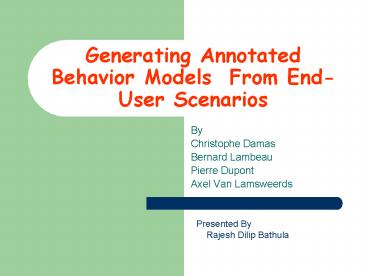Generating Annotated Behavior Models From EndUser Scenarios - PowerPoint PPT Presentation
1 / 16
Title:
Generating Annotated Behavior Models From EndUser Scenarios
Description:
Generating Annotated Behavior Models From End-User Scenarios. By. Christophe Damas. Bernard Lambeau. Pierre Dupont. Axel Van Lamsweerds. Presented By ... – PowerPoint PPT presentation
Number of Views:36
Avg rating:3.0/5.0
Title: Generating Annotated Behavior Models From EndUser Scenarios
1
Generating Annotated Behavior Models From
End-User Scenarios
- By
- Christophe Damas
- Bernard Lambeau
- Pierre Dupont
- Axel Van Lamsweerds
Presented By Rajesh Dilip Bathula
2
Aim
- To develop tool-supported techniques that
overcome the problems like
- 1. Additional input like state assertions or
flowcharts on episodes which are difficult to be
used by non-expert end-users. - 2.Validation of the generated state machines,
which is difficult for analysts. - in synthesizing behavior models inductively
from scenarios.
3
Introduction
- Scenarios
- Labeled Transition System (LTS)
- Message Sequence Charts (MSC)
- Agent
- Fluents
4
Basic Idea
- A global LTS for the entire system is synthesized
first, this covers all scenario examples. - The procedure is incremental on training
examples. - The synthesized system LTS is then projected on
local LTS for each system component. - For model validation by analysts, the tool
generates state invariants that decorate the
nodes of the local LTS.
5
Example
- A simple train system is composed of three
agents - i. Train Controller
- ii. Train actuator/sensor
- iii. Passengers
6
Generating annotated state machines from end-user
scenarios
7
3 Steps
- Step 1 Submitting an initial set of positive and
negative scenarios. - Step 2 Generating scenario questions and
synthesizing agent LTS. - Step 3 Generating state invariants to document
the generated state machines.
8
Step 1 3 positive and 1 negative scenarios
9
Step 2
10
Step 2 (contd)
11
Step 2 is attained by
- i. LTS synthesis as a Grammar Induction
problem using RPNI algorithm. - ii. Interactive synthesis of the system LTS
using the Merge function. - iii. Projecting the global system LTS on
agents.
12
Step3 a)before decoration
b)decorated with state variables
13
Step 3 is attained by
- Decorating states with Fluents.
- Forming the State Invariant.
14
Case studyMine Pump Control System
- This tool supported technique is implemented here
to avoid the problem of explosion in the mine due
to over level of methane gas.
15
Conclusion
- A new approach has been presented for
synthesizing behavior models from simple forms of
scenarios.. - A new fix point algorithm has been descried for
generating state invariants on labeled transition
systems so as to make such models easier to
understand and validate-especially as they are
automatically generated from scenarios.
16
- Thank you!































